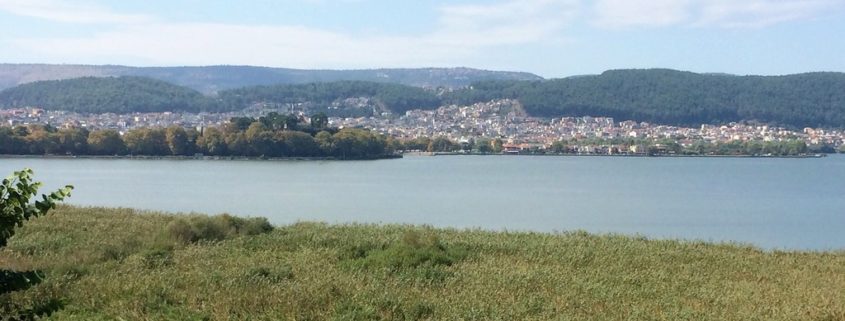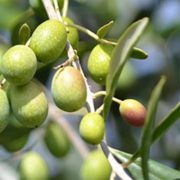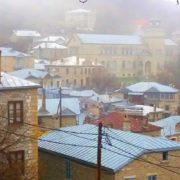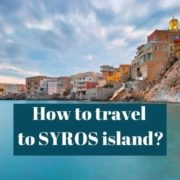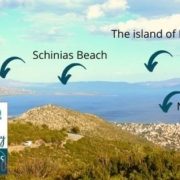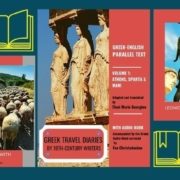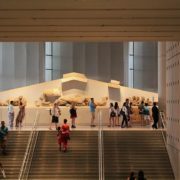A student from Belgium who has been studying Greek for many years, not only in his home country, but also at Omilo during the summer, went on a trip in September of 2018 to Western and Central Greece. We are pleased that he has written about his experiences in fluent Greek and shared them with Omilo. Below you will find an account of his trip, and the translation in English.
If you intend to see these wonderful places, perhaps this travelogue will help you decide which of them to visit while at the same time teaching you some new vocabulary. We hope you enjoy Emiel’s letter!
My dear friends,
The longer you wait, the harder it is to remember certain things…so I finally did it!
I have written an account of my travels to Ioannina and Zagorochoria as well as to Meteora—and what’s more, in Greek, in order to get some practice writing the language!
First of all, Ioannina and Zagorochoria as well as Meteora are really worth seeing! They are truly hidden treasures of northwestern Greece. We had quite a successful trip, taking home with us many beautiful memories!
Our itinerary was as follows:
Monday: Ioannina
Tuesday: Ioannina
Wednesday: Zagorochoria. western villages: Aristi, Vikos, Agios Trifonas, Farangi Tou Bikou (Vikos Gorge), Papigo (1000 m.), Mikro Papigo.
Thursday: Zagorochoria central villages: Ano Pedina (1000 m.), Monodendri (Evangelistrias Monastery, Agias Papaskevis Monastery, Oxia (by car), view of the gorge.
Friday: Ioannina. Vrelli Museum, Dodoni.
Saturday: Meteora, Kalambaka, Kastraki.
Sunday: Zagorochoria, central villages: Dilopho, Kipi, Koukouli, Vradeto (1300) Vella, view of gorge.
Monday: Ioannina
Tuesday: Return home
Ioannina: what we saw
Ioannina is a lively university town, and we were impressed by the picturesque lake with its little island and the surrounding tall mountains. We learned a lot about the history of the city from 1204 to 1913, including the Ottoman occupation, the life of Ali Pasha and the story of Kyra Frosini and her tragic end. The city has striking scenery and important sights; nevertheless, the historical buildings are somewhat neglected and in need of cleaning. It is clear that the city lacks the means with which to properly maintain its cultural legacy.
The castle with its surrounding walls and the narrow lanes of the old city made an impression on us. We visited the two citadels, one called Its Kale and the other Aslan Pasha. The first was more interesting, with its Byzantine Museum and the tomb of Ali Pasha. Inside the walls of the castle, there are no shops, only residences and a hotel. However, we did find a little café where you can have something to eat or drink. This establishment, called “Arte Povera,” belongs to a young couple who opened it not long ago. If you are in the area, it’s worth going in. There you can try out products that are organically grown or purchase various objects made of pinewood. A visit to this cafe is definitely worth it!
We didn’t swim in Ioannina Lake, but we did take a walk along the shore. One day, we went for a meal at a restaurant called Filippa and then went by boat to the little island in the middle of the lake.
The Archaeological Museum of Ioannina mostly contains artifacts from all over Epirus. For us, the most important part of the museum was the hall featuring objects from the Dodoni Sanctuary, the oldest oracle of Greece. There you can find lead panels etched with questions for the Oracle, questions referring to the cares and troubles of everyday life. It’s fun to read what people worried about back then!
The Pavlos Vrelllis Greek History Museum: there, we journeyed into the history of various regions of Greece. The museum chiefly features the work of Pavlos Vrellis. Unbelievable! This man was persistent; he worked tirelessly on it for 13 years. The museum is certainly worth a visit, but once is enough. Inside, you can see many pictures taken during the national wars of liberation. In total, there are 36 subjects depicted, most of which show the ferocity of the Ottoman oppressors. You will appreciate your visit even more if you know something about Greek history.
Because the Dodoni region is nearby, we went to the Dodoni archaeological site. There we admired the ancient Dodoni Theatre and took the opportunity to ask the gods a few questions about the elections in Ghent (our question was who the next mayor of Ghent would be). An answer came, and even though the sacred oracle was somewhat difficult to understand, in the end, it did give us the correct name!
Restaurants where we went to eat: The Frontzou Politeia, the Fisa-Roufa with traditional food, the Filippas with a lovely view of the lake, the Presbeia, the Mistagogia, the Averof, the HBH with traditional food. We recommend all of them!
Zagorochoria
The visit to Zagori alone really makes the trip worthwhile!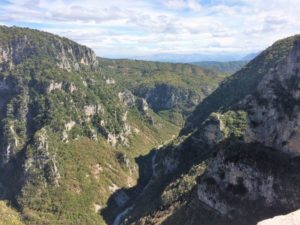
We visited western and central Zagori. We began with Aristi, Vikos, and Megalo as well as Mikro Papigo. The next day we continued with Ano Pedina and Monodendri. In Mikdro Papigo, even though we hadn’t made reservations, we found a room at a hotel called the Mikro Papigo 1700. The next day a local resident told us that the hotel owner was Kostas Kenteris, an athlete who decided not to participate in the Olympic Games in 2004 because of doping—something that I remembered very well! The hotel enjoys a beautiful view, and the next morning we had a delicious breakfast prepared for us a very nice young woman from Albania.
On Sunday we went back to Zagori and visited the villages of Dilofo, Kipoi, and Vradeto. Zagori has enchanting views. There you walk in beautiful countryside, in natural surroundings steeped in history and culture. Zagori lies hidden behind the mountains, near the border with Albania.
Everything about the place is impressive: the mansions, the arched bridges, the stone houses, the stone-paved paths, the deserted monasteries!
We especially liked Megalo and Mikro Papigo as well as Dilofo. Both Megalo and Mikro Papigo were fairly touristy; many houses had been restored, in contrast to Dilofo, whose homes were still in their original, authentic state.
Vikos Gorge
We were able to enjoy a better view of Faraggi Tou Biko (Vikos Gorge) from three different spots: the first in Vikos, the second in Oxia (six kilometers from Monodendri) and the third in Vradeto. From there we hiked to Vella.
Meteora / Kalambaka / Kastraki
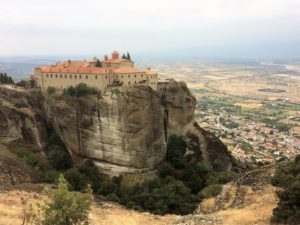 Meteora is a unique geological phenomenon, a wonder of the world, with impressive monasteries built atop immense natural stone pillars. Out of the six monasteries, we visited four: the Monastery of Agios Nikolaus Anapavsas (with one monk), the Monastery of Barlaam (with ten monks) and the Convent of Agios Stefanos (with 36 nuns!). Amazing!
Meteora is a unique geological phenomenon, a wonder of the world, with impressive monasteries built atop immense natural stone pillars. Out of the six monasteries, we visited four: the Monastery of Agios Nikolaus Anapavsas (with one monk), the Monastery of Barlaam (with ten monks) and the Convent of Agios Stefanos (with 36 nuns!). Amazing!
It was a good decision that we skipped Pilio, Makrinitsa, Volos, etc. It would have been too much. That decision gave us the opportunity to go back via Egnatia Highway, but this time during the day. Thus we got a better look at that new and easily navigable road with its many bridges and tunnels. I read that quite a few bears have been run over and killed after they climbed over the fences. I imagine that since then a solution to this problem has been found.
So, that just about wraps it up.
I thank you again for all of the helpful information and suggestions you gave us before we started our trip. They were really very useful.
All the best,
Emiel
Note from Omilo:
If you want to combine Emiel’s suggestions with visiting Thessaloniki as well, click here to get more tips for Thessaloniki
https://omilo.com/thessaloniki-some-secrets/

